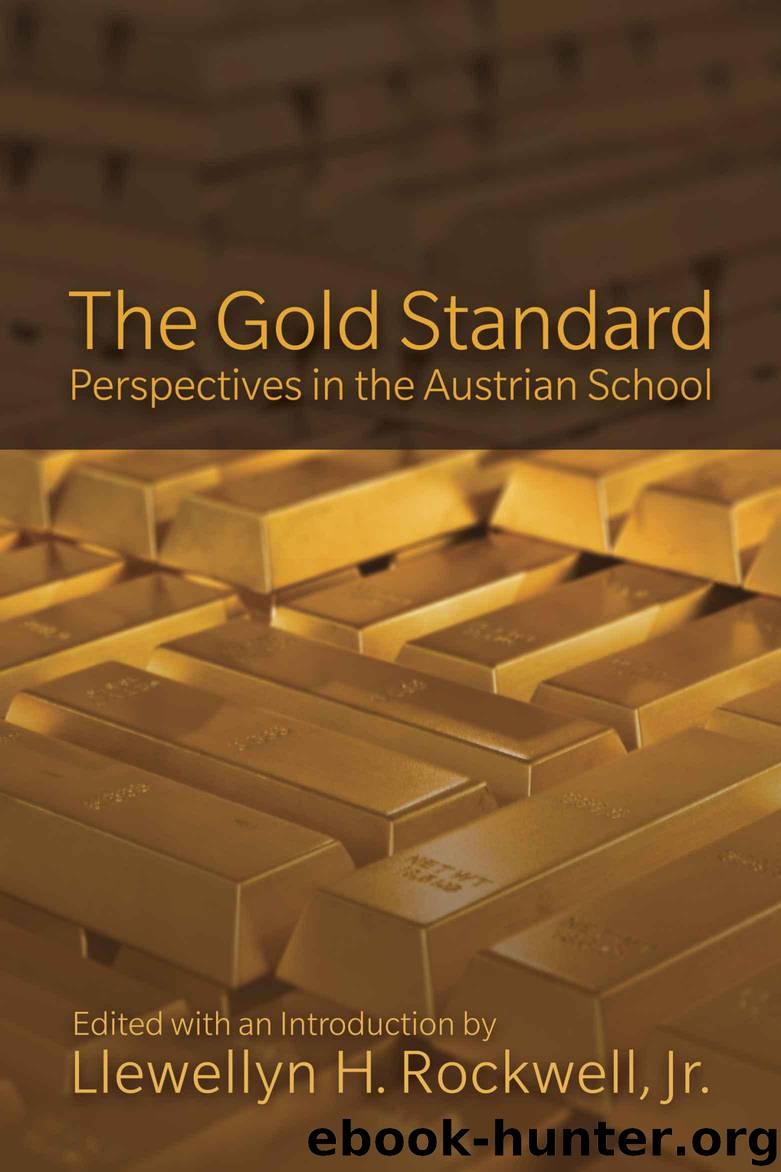The Gold Standard by Llewellyn H. Rockwell Jr

Author:Llewellyn H. Rockwell, Jr.
Language: eng
Format: mobi
ISBN: 9781610166119
Published: 2013-09-22T16:00:00+00:00
A Constant Price Level versus Monetary Stability
The assumption of a constant price level has a history that is both long and wide. Over the years theorists representing diverse schools of thought have invoked this assumption in their effort to abstract from monetary influences on the course of economic activity, and they have adopted as a self-evident truth the notion that a constant price level is the hallmark of monetary stability. The significance of a constant price level for both theory and policy has been taken to be so obvious and self-evident that the literature is virtually devoid of attempts to defend these common practices. Yet a sampling of the many writers who do not question this assumption, and of the few who do, exposes the assumption as the Achilles’ heel of the popular stance against the gold standard and of many other theoretical pronouncements and policy prescriptions.
Hayek noted in the early 1930s that an unaccountable preeminence of the constant price level characterized the writings of such monetary notables as Gustav Cassel and A.C. Pigou.[21] That a country should regulate its currency so as to achieve a constant price level appeared to Cassel as the “simplest assumption.” If a country’s currency were so regulated, money would exert no influence of its own, according to Pigou. The idea that an equality between economic growth and monetary growth is “natural” and that money whose growth rate satisfies this equality is “neutral” had become commonplace by the end of the twenties. The general acceptance of this idea eliminated the need for a theoretical justification.
The assumed relevance and desirability of a constant price level are incorporated in later decades in the writings of U.S. economists. In the early 1950s Clark Warburton included in his list of assumptions that underlie monetary theory the need for monetary growth to accommodate real economic growth. “[A]s a result of [population growth, technological developments, and increasing labor productivity] and of the stability of customs (such as the periodicity of income payments) which affect the rate of circulation of money, the economy needs for equilibrium a continuous increase in the quantity of money.”[22] Following suit, Friedman assumed “for convenience” that a stable price level of final products is the objective of policy.[23] (It is both revealing and disquieting to note that Friedman’s estimate of the resource costs of a gold standard discussed earlier in this chapter depends critically upon an assumption that was made for the sake of convenience.)
In the late 1960s Friedman reaffirmed that he “simply took it for granted, in line with a long tradition and near-consensus in the profession, that a stable level of prices of final products was a desirable objective.”[24] The purpose of the article that contains this statement was to replace the assumed optimum of a constant price level with a theoretically derived optimum. After identifying costs and benefits of a changing price level, Friedman, following standard microeconomic procedures, set the marginal costs equal to the marginal benefits and solved for the optimal, or welfare-maximizing, rate of change in the price level.
Download
This site does not store any files on its server. We only index and link to content provided by other sites. Please contact the content providers to delete copyright contents if any and email us, we'll remove relevant links or contents immediately.
International Integration of the Brazilian Economy by Elias C. Grivoyannis(72873)
The Radium Girls by Kate Moore(11594)
Turbulence by E. J. Noyes(7682)
Nudge - Improving Decisions about Health, Wealth, and Happiness by Thaler Sunstein(7220)
The Black Swan by Nassim Nicholas Taleb(6745)
Rich Dad Poor Dad by Robert T. Kiyosaki(6158)
Pioneering Portfolio Management by David F. Swensen(6057)
Man-made Catastrophes and Risk Information Concealment by Dmitry Chernov & Didier Sornette(5630)
Zero to One by Peter Thiel(5471)
Secrecy World by Jake Bernstein(4370)
Millionaire: The Philanderer, Gambler, and Duelist Who Invented Modern Finance by Janet Gleeson(4071)
The Age of Surveillance Capitalism by Shoshana Zuboff(3968)
Skin in the Game by Nassim Nicholas Taleb(3957)
The Money Culture by Michael Lewis(3822)
Bullshit Jobs by David Graeber(3809)
Skin in the Game: Hidden Asymmetries in Daily Life by Nassim Nicholas Taleb(3714)
The Dhandho Investor by Mohnish Pabrai(3548)
The Wisdom of Finance by Mihir Desai(3513)
Blockchain Basics by Daniel Drescher(3314)
